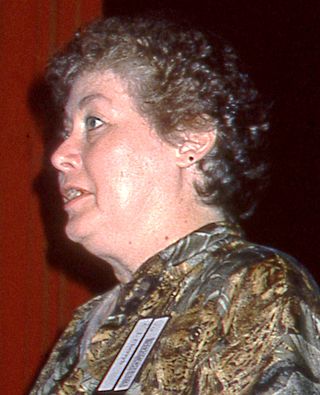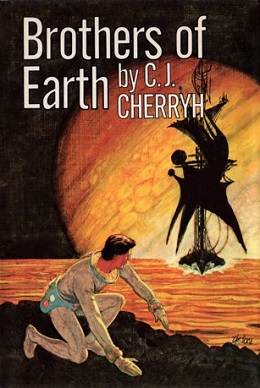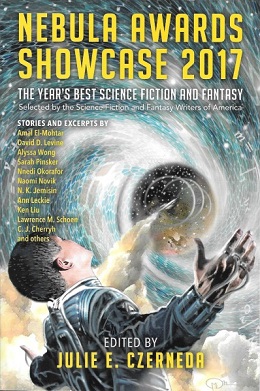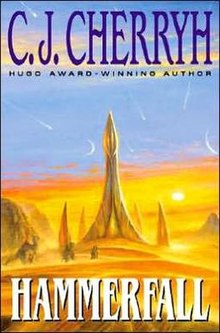
Carolyn Janice Cherry, better known by the pen name C. J. Cherryh, is an American writer of speculative fiction. She has written more than 80 books since the mid-1970s, including the Hugo Award–winning novels Downbelow Station (1981) and Cyteen (1988), both set in her Alliance–Union universe, and her Foreigner series. She is known for worldbuilding, depicting fictional realms with great realism supported by vast research in history, language, psychology, and archeology.

Rusalka is a fantasy novel by American science fiction and fantasy author C. J. Cherryh. It was first published in October 1989 in the United States in a hardcover edition by Ballantine Books under its Del Rey Books imprint. Rusalka is book one of Cherryh's three-book Russian Stories trilogy set in medieval Russia in forests along the Dnieper river near Kyiv in modern-day Ukraine. The novel draws on Slavic folklore and concerns the fate of a girl who has drowned and becomes a rusalka. It is also an exploration of magic and the development of a young wizard.

The Collected Short Fiction of C. J. Cherryh is a collection of science fiction and fantasy short stories, novelettes and novella written by American author C. J. Cherryh between 1977 and 2004. It was first published by DAW Books in 2004. This collection includes the contents of two previous Cherryh collections, Sunfall (1981) and Visible Light (1986), all of the stories from Glass and Amber (1987), stories originally published in other collections and magazines, and one story written specifically for this collection ("MasKs"). Cherryh's 1978 Hugo Award winning story, "Cassandra" is also included.

Downbelow Station is a science fiction novel by American writer C. J. Cherryh, published in 1981 by DAW Books. It won the Hugo Award in 1982, was shortlisted for a Locus Award that same year, and was named by Locus magazine as one of the top 50 science fiction novels of all time in 1987.

The Finisterre universe is a fictional universe created by American science fiction and fantasy author C. J. Cherryh. Currently, it comprises a series of two science fiction / horror novels written by Cherryh, Rider at the Gate (1995) and Cloud's Rider (1996), also known as The Rider Series. They were published by Warner Books in the US and Hodder & Stoughton in the United Kingdom. The series is about the descendants of lost colonists stranded many generations ago on the hostile planet of Finisterre. For continuity, the two novels should be read in publication sequence.

American writer C. J. Cherryh's career began with publication of her first books in 1976, Gate of Ivrel and Brothers of Earth. She has been a prolific science fiction and fantasy author since then, publishing over 80 novels, short-story compilations, with continuing production as her blog attests. Cherryh has received the Hugo and Locus Awards for some of her novels.

The Cherryh Odyssey is a 2004 collection of essays by various academics, critics and authors about American Hugo Award-winning science fiction and fantasy author, C. J. Cherryh. It was edited by author and academic, Edward Carmien, and was published by Borgo Press, an imprint of Wildside Press as part of its Author Study series. Locus Magazine put the book on its "2004 Recommended Reading List", and Carmien received a nomination for the 2005 Locus Award for Best Non-fiction book for The Cherryh Odyssey.

Gate of Ivrel is a 1976 novel by American writer C. J. Cherryh, her first published work. It is the first of four books composing the Morgaine Stories, chronicling the deeds of Morgaine, a woman consumed by a mission of the utmost importance, and her chance-met companion, Nhi Vanye i Chya.

Forge of Heaven is a science fiction novel by American science fiction and fantasy author C. J. Cherryh. It was first published in June 2004 in the United States by HarperCollins under its Eos Books imprint.

Alternate Realities is a 2000 omnibus collection of three short science fiction novels by American writer author C. J. Cherryh: Wave Without a Shore (1981), Port Eternity (1982), and Voyager in Night (1984). All three novels are set in Cherryh's Alliance-Union universe and share a common theme of people encountering and coping with a reality different from their own.
Azi are a fictional type of human clones invented by science fiction and fantasy author C. J. Cherryh. They appear in various books in her Alliance-Union universe. "Azi" is an acronym for "artificial zygote insemination". The subject is treated at length in Cherryh's 1989 novel Cyteen and its 2009 sequel, Regenesis.

Serpent's Reach is a 1980 science fiction novel by American writer C. J. Cherryh. The book was nominated for the Locus Award for Best Novel in 1981. It is set in the author's Alliance-Union universe.

Tripoint is a science fiction novel by the United States science fiction and fantasy author C. J. Cherryh, first published by Warner Books in September 1994. It is one of Cherryh's Merchanter novels and is set in the author's Alliance-Union universe.

The Dreamstone is a 1983 fantasy novel by American writer C. J. Cherryh. It includes revisions of the author's 1979 short story "The Dreamstone" and her 1981 novella Ealdwood, plus additional material. The book is the first of two novels in Cherryh's Ealdwood Stories series, the second being The Tree of Swords and Jewels. The series draws on Celtic mythology and is about Ealdwood, a forest at the edge of Faery, and Arafel, a Daoine Sidhe.

Brothers of Earth is a 1976 science fiction novel by American writer C. J. Cherryh. It was the second of Cherryh's novels to be published, appearing after Gate of Ivrel, although she had completed and submitted Brothers of Earth first. Donald A. Wollheim, the editor of DAW Books, decided that publishing Gate of Ivrel first would be more commercially desirable, so Brothers of Earth was delayed until the former was released.

Lois & Clark: A Superman Novel is a superhero fiction novel by American science fiction and fantasy writer C. J. Cherryh. It is based on the television series Lois & Clark: The New Adventures of Superman and is about the romance between Superman universe characters Lois Lane and Clark Kent.
Several themes recur throughout the works of American science fiction and fantasy author C. J. Cherryh.

Regenesis (2009) is a science fiction novel by American writer C. J. Cherryh, set in her Alliance-Union universe. It is a sequel to Cherryh's Cyteen, and was published in hardcover by DAW Books in January 2009. The teenage clone of a top scientist and political leader unravels the decades-old murder of her "genemother", while also dealing with threats to her own welfare.

Sisterhood of Dune is a 2012 science fiction novel by Brian Herbert and Kevin J. Anderson, set in the Dune universe created by Frank Herbert. It is the first book in their Great Schools of Dune prequel trilogy, which itself is a sequel to their Legends of Dune trilogy. The book is set eighty years after the events of 2004's Dune: The Battle of Corrin, in which the human military finally defeat the thinking machine armies of Omnius. Now, the fledgling Bene Gesserit, Mentat and Suk Schools, as well as the Spacing Guild, are threatened by the independent anti-technology forces gaining power in the aftermath of the Butlerian Jihad. The Great Schools of Dune trilogy, first mentioned by Anderson in a 2010 blog post, will chronicle the early years of these organizations, which figure prominently in the original Dune novels.

Nebula Awards Showcase 2017 is an anthology of science fiction and fantasy short works edited by Canadian writer Julie E. Czerneda. It was first published in trade paperback and ebook by Pyr in May 2017.


















